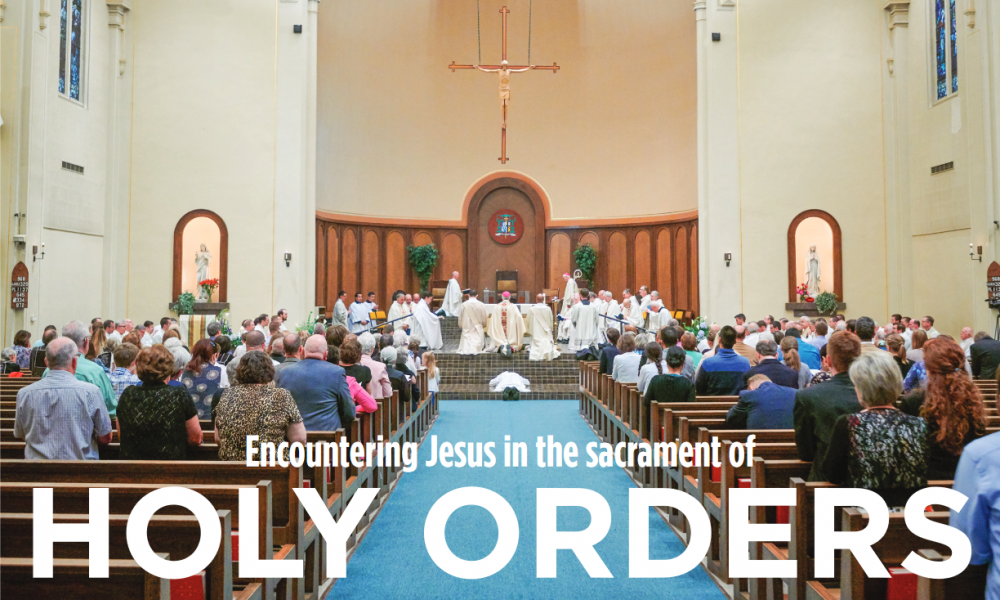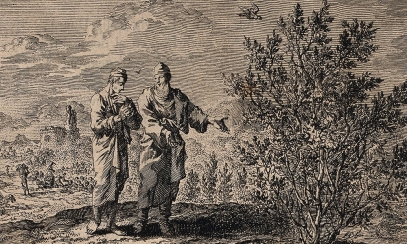
Encountering Jesus in the Sacrament of Holy Orders
Holy orders, or the sacrament of apostolic ministry, is the sacramental act that incorporates a man into one of three recognized “orders”: bishop (ordo episcoporum), presbyter or priest (ordo presbyterorum) or deacon (ordo diaconorum). It is through this sacrament that the mission entrusted by Christ to his apostles continues to be exercised in the Church.
What happens at ordination?
The ordination of a bishop, priest or deacon takes place within the Eucharistic liturgy. Its essential rite consists of the laying on of hands by the bishop and of the consecratory prayer which together constitute the visible sign of ordination.
Like baptism and confirmation, ordination imprints an “indelible sacramental character” upon the ordained that cannot be repeated or conferred temporarily. Through his ordination, the recipient is configured to Christ so that he may serve as Christ’s instrument for his Church.
There are also additional rites that make up an ordination. Initial rites consist of the following: presentation and election of the ordinand (those to be ordained), instruction by the bishop, examination of the candidate and the litany of the saints. The rites all attest that that choice of candidate is made in keeping with the practice of the Church and prepares him for the consecration.
After the consecration, rites symbolically express and complete the mystery accomplished. For a bishop, there is an anointing of holy chrism (a sign of the Holy Spirit who alone will make his ministry fruitful); the giving of the book of the Gospels (as the sign of his apostolic mission to proclaim the word of God), the ring (a sign of his fidelity to the Church) and the miter and the crosier (signs of his office as shepherd of the Lord’s flock).
For a priest, there is also an anointing with holy chrism plus the presentation to the priest of the paten and chalice, symbolizing “the offering of the holy people” which he is called to present to God. Finally, there is the giving of the book of the Gospels to the deacon who has just received the mission to proclaim the Gospel of Christ.
Who can receive this sacrament?
The catechism (1577) teaches that, "Only a baptized man validly receives sacred ordination." The reason for this lies in the fact that Jesus chose men as the twelve apostles, and these apostles did the same when they chose their successors. Today, the college of bishops continues to make the twelve apostles an “ever-present and ever-active reality until Christ’s return.” As the Church believes herself bound to the choice made by Jesus, the ordination of women is not possible. That said, “no one has a right to receive the sacrament.” One is called to it by God and it “can be received only as an unmerited gift.” (1578)
The effects of the sacrament of holy orders
Through the grace of the Holy Spirit, the sacrament configures the person to Christ “as Priest, Teacher, and Pastor.” (1585) The bishop receives the grace of strength, or “governing spirit.” This is the grace to guide and defend the Church with strength and prudence. The catechism (1586) explains this grace “impels him to proclaim the Gospel to all, to be the model for this flock, to go before it on the way of sanctification by identifying himself in the Eucharist with Christ the priest and victim, not fearing to give his life for his sheep.”
For the priest, ordination confers the spiritual gift to proclaim the Gospel, to offer spiritual gifts and sacrifices, and to renew the people through Baptism. The deacon receives the grace to be in service to the liturgy, the Gospel and works of charity.
Did you know …
While priests in religious orders take vows, diocesan priests make promises. In particular, they promise to live celibate and to be obedient and respectful to the bishop. The promise of celibacy is actually made by the ordinand at his diaconate ordination. The promise of obedience immediately follows the examination rite mentioned in the previous segment when the ordinand places his hands within the hands of the bishop.
The role of the bishop/priest in the liturgy
The bishop or priest presides over the liturgy. Essentially, this means the bishop or priest fulfills two vital and interrelated functions during the liturgy: he represents Christ to the Church and he presents the Church’s prayer to God.
By the sacrament of holy orders, the priest is anointed by the Holy Spirit who enables the priest to “act in the person of Christ the head”, or in persona Christi capitis. This means that within the context of the priest’s service to the Church, it is Christ himself who is present as the Church’s head through the action of the priest. In this way, the priest becomes an “icon” of Christ.
At the same time, because the ordained minister represents Christ, he also acts in the name of the whole Church when presenting to God the prayer of the Church. This is because the Church is inseparable from Christ, who worships in and through his Church. The whole Church, the Body of Christ and the common priesthood, prays and offers herself through Christ, with Christ, and in Christ – the one priest. The ordained priest’s role here is especially evident in the offering of the eucharistic sacrifice. It is the priest, standing in the person of Christ, who alone can consecrate the bread and wine that will become the very body and blood of Christ offered as the spiritual sacrifice of Christ on behalf of his body, the Church.
The two types of priesthood
The ministerial priesthood is that of bishops and priests. The common priesthood is that of all the faithful. While they are both ordered to each other, they differ essentially. The common priesthood of the faithful is “exercised by the unfolding of baptismal grace – a life of faith, hope, and charity, a life according to the Spirit.” The ministerial priesthood is transmitted by the sacrament of holy orders and confers sacred power for service to the common priesthood. This service is exercised by teaching, divine worship, and pastoral governance. The ministerial priesthood, then, is “a means by which Christ unceasingly builds up and leads his Church.”
Source: Catechism of the Catholic Church (1547)
A difference of degrees
The sacrament of holy orders has three degrees: the episcopate, the presbyterate, and the diaconate. The episcopate and presbyterate both participate in the priesthood of Christ. The diaconate is intended to help and serve these two other degrees.
Episcopal ordination represents the fullness of the sacrament of holy orders. Those receiving this ordination are bishops and are successors to the apostles. Priests belong to the presbyterate. They are ordained to be co-workers of the bishops and an extension of their ministry. Finally, deacons belong to the diaconate and “assist the bishop and priests in the celebration of the divine mysteries, above all the Eucharist, in the distribution of Holy Communion, in assisting at and blessing marriages, in the proclamation of the Gospel and preaching, in presiding over funerals, and in dedicating themselves to the various ministries of charity.”
Source: Catechism of the Catholic Church (1554-1570)



